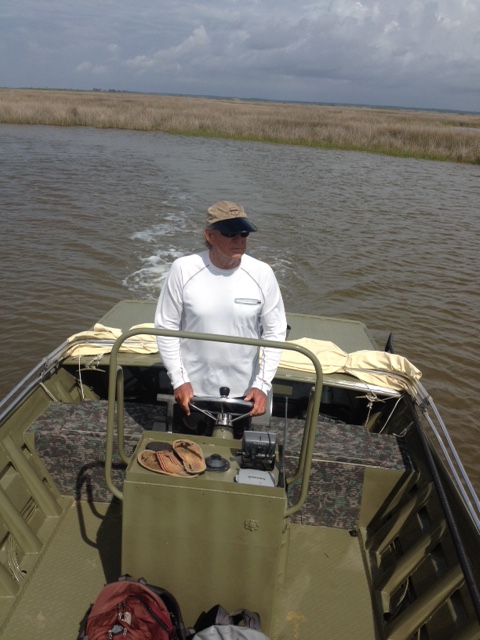
by Rick O'Connor | Dec 17, 2021
Recently I watched a documentary on TV entitled The Loneliest Whale; the search for 52. The title grabbed my attention and so, I checked it out.
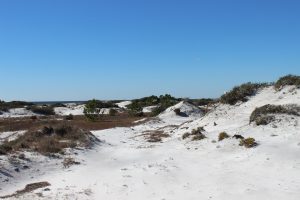
There are many forms of wildlife that are very hard to find in our area. But we continue to look.
Photo: Rick O’Connor
Seems a decade or so ago the U.S. Navy was doing SONAR work in the Pacific between Washington and Alaska and detected a strange sound coming in at 52 hertz. They had not herd this before and would continue to hear it in different locations around the northern Pacific. Their first concern was it was something new from the Russians, but when they showed the graphs and played the recording to a marine mammologist named Dr. Watkins, they found that it was most likely a “biological” – mostly likely a whale.
The problem was that Dr. Watkins had never heard whales calling at 52 hertz. If it was a whale, it was calling a lot – but no other whales were answering. Hence the name “the loneliest whale”. If it was a whale, and no others would talk to it, it was kind of sad. But who was this whale? What kind was it?
Word of the loneliest whale spread around the world and many humans made a connection to this animal, possibly because of their own disconnect with their own species. Stories and ballads were written, and people began to feel for the poor animal that apparently had no friends.
This story caught the attention of a documentary film maker who was interested in finding “52”, as the whale became known. He solicited the help of other marine mammologists; Dr. Watkins had died. According to those marine mammologists, this was going to be VERY difficult. It is hard enough to find just a pod of whales in the open Pacific, much less a specific pod with a specific individual. But they were excited about the challenge of finding this one animal, “52”, and off they went.
As I was watching this documentary it reminded me of my own search here near Pensacola. In 2005, I was asked by members of state turtle groups if I could search to see if diamondback terrapins lived in the western panhandle. This turtle’s range is from Cape Cod Massachusetts to Brownsville Texas, but there were no records from the Florida panhandle. Did the animal exist there? I was running the marine science program at Washington High School at the time and thought this would be a good project for us. So, we began.
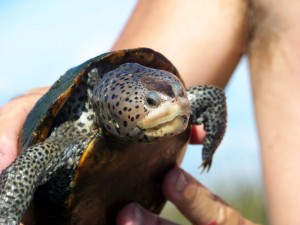
Mississippi Diamondback Terrapin (photo: Molly O’Connor)
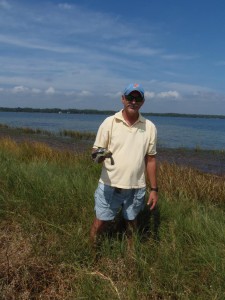
This small turtle can be held safely by grabbing it near the bridge area on each side.
Photo: Molly O’Connor
The students researched terrapin biology and ecology to determine the locations with the highest probability of finding, and we searched. I quickly found that the best time to search for terrapins was during nesting in May and June, and that the worst time to do a project with high school seniors was May and June. So, the project fell on my wife and me. For two years we searched all the “good spots” and found nothing. We placed “Wanted Poster’s” at boat ramps near the good spots with only calls about other species of turtles, not the terrapin.
Then one day in a call came in from a construction worker. Said he had seen the turtle we were looking for. For over a year we had been chasing “false calls” of terrapins. So, I was not overly excited thinking this would be another box turtle or slider. I asked a few questions about what he was looking at and he responded with “you’re the guy who put the wanted poster up correct? – well your turtle is standing next to the poster… it’s the same turtle”. Now I was excited. We did some surveys in that area and in 2007 saw our first terrapin! I can’t tell you how exciting it was. Two years of searching… at times thinking we might work on another project with a different species that actually exists… reading that the diamondback terrapin is like the Loch Ness monster – everyone talks about them, but no one has ever seen one. And there it was, a track in the sand and a head in the water. Yes Virginia… terrapins do exist in the Florida panhandle. The excitement of finding one was indescribable.
We were hooked. We now had to look in other counties in the panhandle, and yes, we found them. As I watched the program of the marine mammologists searching for “52” I could completely relate.
Today, as a marine educator with Florida Sea Grant, I train others how to do terrapin surveys and searches. I let them know how hard it is to find them and to not get disappointed. When they do see one, it will be a very exciting and fulfilling day. Our citizen science program has expanded to searching for other elusive creatures in our bay area. Bay scallops, which are all but gone however we do find evidence of their existence and spend time each year searching for them. In the five years we have been searching we have found only one live scallop, but we are sure they are there. We find their cleaned shells on public boat ramps – by the way, it is illegal to harvest bay scallops in the Pensacola Bay area. Another we are searching for is the nesting beaches of the horseshoe crabs. This is another animal that basically disappeared from our waters but are occasionally seen now. It is exciting to find one, but we are still after their nesting beaches and the chase is on.
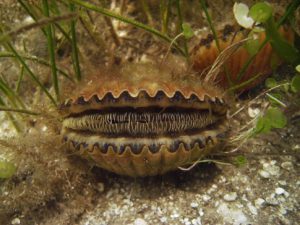
Bay Scallop Argopecten irradians
http://myfwc.com/fishing/saltwater/recreational/bay-scallops/

Horseshoe crabs breeding on the beach.
Photo: Florida Sea Grant
I love the challenge of searching for such creatures. If you do as well, we have a citizen science program that does so. You can just contact me at the Escambia County Extension Office to get on the training list, trainings occur in March, and we will get you out there searching. As for whether they found “52”, you will have to watch the program 😊
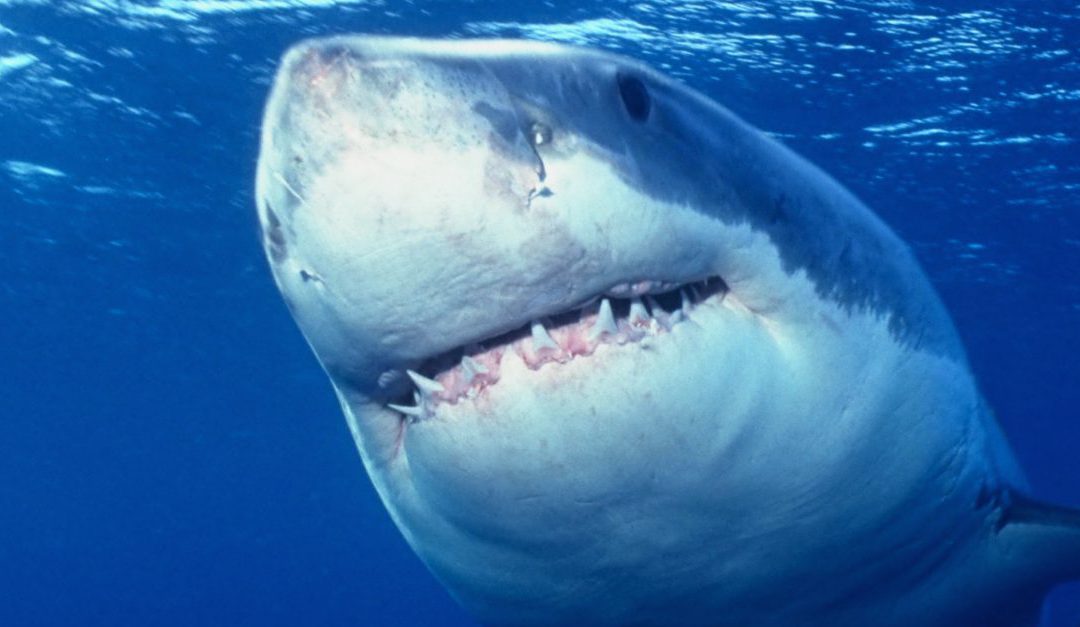
by Laura Tiu | Sep 11, 2020
When one thinks of the Emerald Coast, visions of sparkling water, baby-powder beaches, rental houses and high-rises interwoven with seafood and pizza restaurants appear. The coast is dotted with fishing boats, pirate ships and dolphin cruises and the beaches are littered with people. But it is what glides under the water that some people are curious about. “Are there sharks in the water here?” is a question I often get from locals and tourists alike. The answer is yes, sharks call saltwater home.
Sharks evoke a variety of emotions in people. Some folks are fascinated and list shark fishing and diving with a shark on their bucket lists. Others are terrified, convinced that sharks only exist to hunt them and bite them while they take a swim. Unfortunately for the sharks, their appearance plays into this later fear, with sharp teeth, unblinking eyes and sleek bodies. The reality is that most sharks only grow up to three feet in length and eat small shrimp, crabs and shrimp, not humans. But it is true that bull, tiger and great white sharks are all large species that have been known to attack humans.
Of the 540 different species of sharks in the world, there are about twelve that call the Emerald Coast home including Atlantic sharpnose, bonnet head, blacktip, bull, dusky, great white, hammerhead, nurse, mako, sand, spinner, and tiger. They don’t all stick around all year, with some migrating south in the winter, while others migrate north.
Sharks use their seven senses to interpret their environment: smell, sight, sound, pressure, touch, electroreception, and taste. Most shark attacks occur when a human is mistakenly identified as prey. There are some easy measures you can take to reduce the risk.
- Swim with others, this may intimidate sharks and allows someone to go for help if a bite occurs.
- Remove jewelry as it can look like an attractive shiny fish underwater.
- Don’t swim where folks are fishing as bait in the water may attract sharks.
- Pay attention to any schools of baitfish in the area that may be attracting sharks.
- Do not swim at dusk or dawn when visibility may be poor.
- Learn how to identify various shark species
Remember, shark attacks on humans are rare. Reports of stepping on stingrays, jellyfish stings, lightning, dangerous surf conditions and car accidents greatly outnumber the number of shark attacks every year.
For more information: https://www.floridamuseum.ufl.edu/sharks/education-resources/
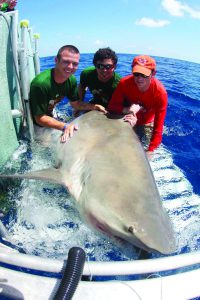
A bull shark being tagged by researchers (credit: Florida Sea Grant).
“An Equal Opportunity Institution”
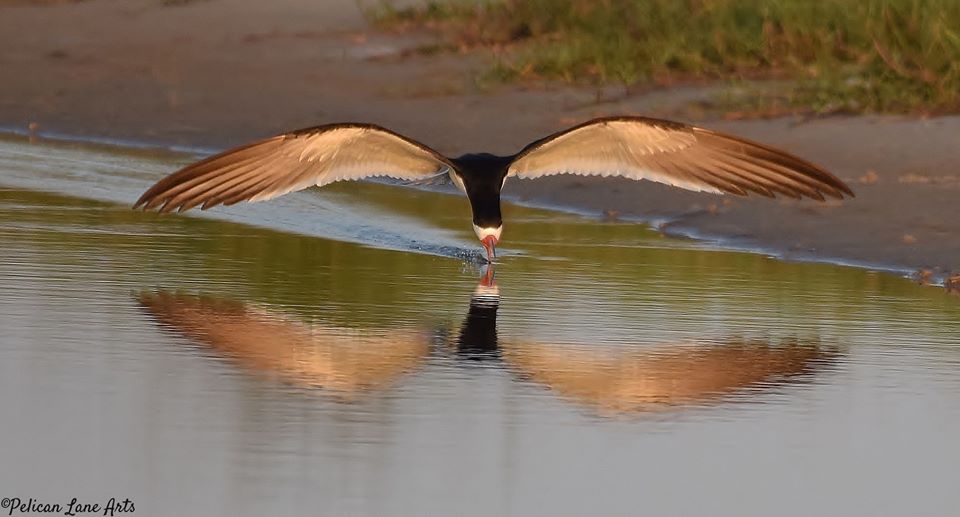
by Chris Verlinde | May 1, 2020
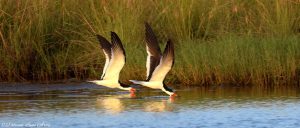
Black Skimmers foraging for fish. Photo Credit: Jan Trzepacz, Pelican Lane Arts.
Black Skimmers and Least Terns, state listed species of seabirds, have returned along the coastal areas of the northern Gulf of Mexico! These colorful, dynamic birds are fun to watch, which can be done without disturbing the them.
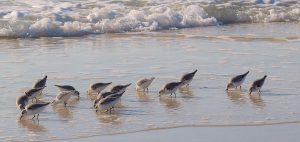
Shorebirds foraging. Photo Credit: Jan Trzepacz, Pelican Lane Arts.
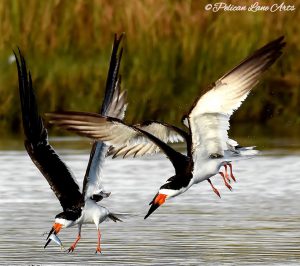
Black Skimmer with a fish. Photo Credit: Jan Trzepacz, Pelican Lane Arts.
What is the difference between a seabird and shorebird?
Among other behaviors, their foraging habits are the easiest way to distinguish between the two. The seabirds depend on the open water to forage on fish and small invertebrates. The shorebirds are the camouflaged birds that can found along the shore, using their specialized beaks to poke in the sandy areas to forage for invertebrates.
Both seabirds and shorebirds nest on our local beaches, spoil islands, and artificial habitats such as gravel rooftops. Many of these birds are listed as endangered or threatened species by state and federal agencies.
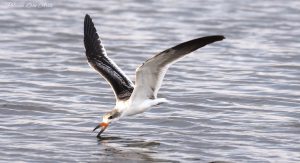
Juvenile Black Skimmer learning to forage. Photo Credit: Jan Trzepacz, Pelican Lane Arts.
Adult black skimmers are easily identified by their long, black and orange bills, black upper body and white underside. They are most active in the early morning and evening while feeding. You can watch them swoop and skim along the water at many locations along the Gulf Coast. Watch for their tell-tale skimming as they skim the surface of the water with their beaks open, foraging for small fish and invertebrates. The lower mandible (beak) is longer than the upper mandible, this adaptation allows these birds to be efficient at catching their prey.
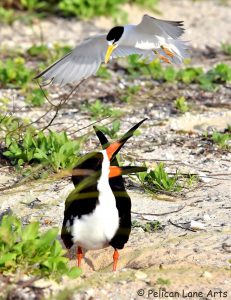
Least Tern “dive bombing” a Black Skimmer that is too close to the Least Tern nest. Photo Credit: Jan Trzepacz, Pelican Lane Arts.
Adult breeding least terns are much smaller birds with a white underside and a grey-upper body. Their bill is yellow, they have a white forehead and a black stripe across their eyes. Just above the tail feathers, there are two dark primary feathers that appear to look like a black tip at the back end of the bird. Terns feed by diving down to the water to grab their prey. They also use this “dive-bombing” technique to ward off predators, pets and humans from their nests, eggs and chicks.
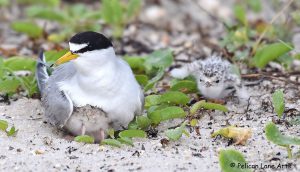
Least Tern with chicks. Photo Credit: Jan Trzepacz, Pelican Lane Arts.
Both Black Skimmers and Least Terns nest in colonies, which means they nest with many other birds. Black skimmers and Least Terns nest in sandy areas along the beach. They create a “scrape” in the sand. The birds lay their eggs in the shallow depression, the eggs blend into the beach sand and are very hard to see by humans and predators. In order to avoid disturbing the birds when they are sitting on their nests, known nesting areas are temporarily roped off by Audubon and/or Florida Fish and Wildlife Conservation Commission (FWC) representatives. This is done to protect the birds while they are nesting, caring for the babies and as the babies begin to learn to fly and forage for themselves.
Threats to these beautiful acrobats include loss of habitat, which means less space for the birds to rest, nest and forage. Disturbances from human caused activities such as:
- walking through nesting grounds
- allowing pets to run off-leash in nesting areas
- feral cats and other predators
- litter
- driving on the beach
- fireworks and other loud noises
Audubon and FWC rope-off nesting areas to protect the birds, their eggs and chicks. These nesting areas have signage asking visitors to stay out of nesting zones, so the chicks have a better chance of surviving. When a bird is disturbed off their nest, there is increased vulnerability to predators, heat and the parents may not return to the nest.
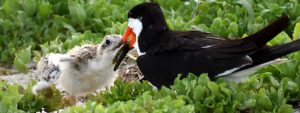
Black Skimmer feeding a chick. Photo Credit: Jan Trzepacz, Pelican Lane Arts.
To observe these birds, stay a safe distance away, zoom in with a telescope, phone, camera or binoculars, you may see a fluffy little chick! Let’s all work to give the birds some space.
Special thanks to Jan Trzepacz of Pelican Lane Arts for the use of these beautiful photos.
To learn about the Audubon Shorebird program on Navarre Beach, FL check out the Relax on Navarre Beach Facebook webinar presentation by Caroline Stahala, Audubon Western Florida Panhandle Shorebird Program Coordinator:
In some areas these birds nest close to the road. These areas have temporarily reduced speed limits, please drive the speed limit to avoid hitting a chick. If you are interested in receiving a “chick magnet” for your car, 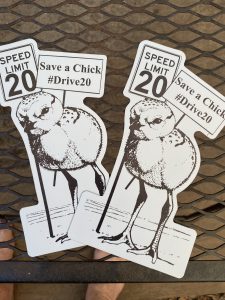 to show you support bird conservation, please send an email to: chrismv@ufl.edu, Please put “chick magnet” in the subject line. Please allow 2 weeks to receive your magnet in the mail. Limited quantities available.
to show you support bird conservation, please send an email to: chrismv@ufl.edu, Please put “chick magnet” in the subject line. Please allow 2 weeks to receive your magnet in the mail. Limited quantities available.

by Rick O'Connor | Jun 22, 2018
Just a decade ago, few people would have known what a gopher tortoise was and would have hard time finding one. But today, because of the protection they have been afforded by the state, they are becoming more common. This is certainly an animal you might see visiting one of our state parks.
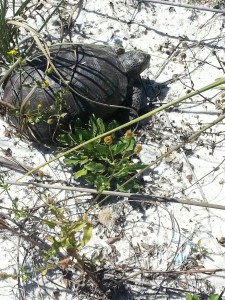
This gopher tortoise was found in the dune fields on a barrier island – an area where they were once found.
Photo: DJ Zemenick
The gopher tortoise is one of only two true land dwelling turtles in our area and is in a family all to its own. They are miners, digging large burrows that can extend up to a depth of 7 feet and a length of 15 feet underground. However, tortoises are not very good at digging up towards the surface, so there is only the one entrance in and out of the burrow. The burrow of the tortoise can be distinguished from other burrowing animals, such as armadillos, in that the bottom line of the opening is flat – a straight line – and the top is domed or arched shaped; mammalian burrows are typically round – circular. Tortoise burrows also possess a layer of dirt tossed in a delta-shaped fan out away from the entrance (called an apron). Many times the soil is from deeper in the ground and has a different color than the soil at the surface. The general rule is one burrow equals one tortoise, though this is not always true. Some burrows are, at times, shared by more than one and some may not be occupied at all. Many field biologists will multiple the number of burrows by 0.6 to get an estimate of how many tortoises there are in the area.
The tortoise itself is rather large, shell lengths reaching 15 inches. They can be distinguished from the other land dwelling turtle, the box turtle, by having a more flattened dome to the shell and large elephant like legs. The forelimbs are more muscular than the hind and possess large claws for digging the burrow. They are much larger than box turtles and do not have hinged plastrons (the shell covering the chest area) and cannot close themselves up within the shell as box turtles can. Tortoises prefer dry sandy soils in areas where it is more open and there are plenty of young plants to eat; box turtles are fans of more dense brush and wooded areas.
Tortoises spend most of the day within their burrows – which remain in the 70°F range. Usually when it is cooler, early morning or late afternoon, or during a rain event – the tortoises will emerge and feed on young plants. You can see the paths they take from their burrows on foraging trips. They feed on different types of plants during different type times of the year to obtain the specific nutrients. There are few predators who can get through the tough shell, but they do have some and so do not remain out for very long. Most people find their burrows, and not the tortoise. You can tell if the burrow has an active tortoise within by the tracks and scrap marks at the entrance. Active burrows are “clean” and not overgrown with weeds and debris. Many times, you can see the face of the tortoise at the entrance, but once they detect you – they will retreat further down. Many times a photo shot within a burrow will reveal the face of a tortoise in the picture. There is a warning here though. Over 370 species of creatures use this burrow to get out of the weather along with the tortoise – one of them is the diamondback rattlesnake. So do not stick your hand or your face into the entrance seeking a tortoise.
Most of the creatures sharing the burrow are insects but there are others such as the gopher frog and the gopher mouse. One interesting member of the burrow family is the Eastern Indigo Snake. This is the largest native snake to North America, reaching a length of eight feet, and is a beautiful iridescent black color. It is often confused with the Southern Black Racer. However, the black racer is not as long, not as large around (girth), and possess a white lower jaw instead of the red-orange colored one of the indigo. The indigo is not dangerous at all, actually it feeds on venomous snakes and it is a good one to have around.
Federal and state laws protect the indigo, as with the gopher frog and mouse. All of these animals have declined in number over the past few decades. This is primarily due to loss of the needed gopher burrows, which have declined because the tortoises have declined, and this is due to habitat loss and harvesting. Again, tortoises like dry sandy soils for digging burrows. They prefer wooded areas that are more open and allow the sun to reach the forest floor where young grasses and flowers can grow. The longleaf pine forest is historically the place to find them but they are found in coastal areas where such open wooded areas exist. The lack of prescribe burning has been a problem for them. Florida is the number one state for lightning strikes. Historically, lightning strikes would occasionally start fires, which would burn the underbrush and allow grasses to grow. In recent years, humans have suppressed such fires, for obvious reasons, and the tortoise community has suffered because of it. Therefore, we now have prescribe fire programs on most public lands in the area. This has helped to increase the number of tortoises in the area and your chance of seeing one.
All of the members of the tortoise community are still protected by state, and – in the case of the indigo snake – federal law, so you must not disturb them if seen. Photos are great and you should feel lucky to have viewed one. Though they could be found anywhere where it is high, dry, and somewhat open – the state and national parks are good places to look.
Reference
Meylan, P.A. (Ed.). 2006. Biology and Conservation of Florida Turtles. Chelonian Research Monographs No. 3, 376 pp.
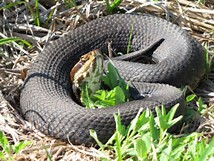
by Rick O'Connor | Aug 11, 2017
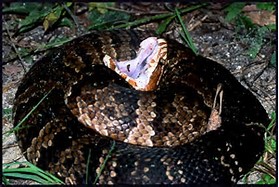
the “cottonmouth” gape of this venomous snakes is a warning. Notice the banded coloration of this individual.
Photo: UF IFAS Wildlife
Also known as the Water Moccasin, this is a snake that is all too familiar with most Floridians… Or is it? Several non-venomous water snakes are often confused with the cottonmouth and are thus killed. That said, cottonmouths are common in the state near areas of water and many residents do have encounters with them. This fact sheet will provide information that help reduce negative encounters with this venomous snake.
DESCRIPTION
- cottonmouths have a relatively thick-stout body with a broad head and thin neck
- they are generally banded and can be brown, gray, reddish in color; many become darker with age and may be solid black; cottonmouths who frequent tannic waters may have cooper color to them
- average length 36″ (3 ft.); max length 74″ (6 ft.)
JUVENILE DESCRIPTION
- copper colored with a yellowish-green tipped tail; used to attract prey
HOW TO TELL FROM NON-VENOMOUS WATER SNAKES
- there are several species of water snakes from the genus Neroidia which are confused with cottonmouths
- the scales between the eyes on top of the head are larger than others on the head; they have narrow necks
- Neroidia will have heads shaped more like your thumb and neck is as wide as head – NOTE: Neroidia CAN WIDEN THEIR HEAD WHEN THREATENED
- when head is viewed from above, the eyes of the cottonmouth are hard to see
- cottonmouths have a creamed colored cheek with dark “mask” extending from eye to back of lower jaw
- Neroidia may have creamed colored cheek but will lack “mask”; will possess thin vertical stripes that extend from lower to upper jaw
- there are single scales extending from the vent (anus) to tip of tail in cottonmouths; those same scales are divided into multiple ones on Neroidia
- the underside of the cottonmouth tail is usually dark; Neroidia is usually lighter in color
- pupil of cottonmouth is elliptical; it is round on Neroidia
- cottonmouths, being members of the pit viper family, will have heat sensing pit between nostril and eye; Neroidia will lack this pit
- scales are keeled, but this is true for some non-venomous snakes
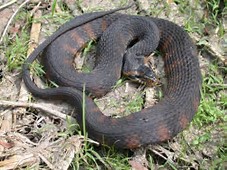
This banded water snake is often confused with the cottonmouth. This animal has the vertical stripes extending from the lower jaw, which is lacking in the cottonmouth.
Photo: University of Georgia
HOW TO TELL FROM OTHER PIT VIPERS
- cottonmouths are often confused with copperheads – both in same genus
- copperheads will lack characteristic “mask” found on cottonmouths and rattlesnakes
- the bands of the copperhead are more uniformed than the cottonmouth and are shaped like an hour glass
- copperheads are generally lighter in color
- it is difficult to tell young copperheads and cottonmouths apart; both have the light yellow-green tipped tail and light body coloring
SUBSPECIES OF COTTONMOUTHS
- there three recognized subspecies of cottonmouths
- the Florida Cottonmouth (Florida (A.p.conanti) – is darker, many times black, with two vertical bars on snout; found throughout the state of Florida
- the Eastern Cottonmouth (A. p. piscivorous) is lighter in color than the Florida and has no pattern on snout; found in extreme western Florida panhandle and the Appalachian valley of Alabama, Georgia, Tennessee, and North Carolina
- the Western Cottonmouth (A.p.leucostoma) – is similar to the eastern cottonmouth but darker in color; found in Mississippi, Louisiana, Texas, and Oklahoma
WHATS IN A NAME
- The Cottonmouth and the Water Moccasin are the two names for the same snake; herpetologist prefer to use the name Cottonmouth
- The snake was originally described by B.G.E. Lace (1789) using the term “piscivorous”; which means “fish eater”
- Gerard Troost (1836) describe the western subspecies using the term “leucostoma”; which means “white mouth”
- Howard Kay Gloyd (1969) described the Florida subspecies using the term “conanti”; which was honoring the herpetologist Roger Conant of the Philadelphia Zoo
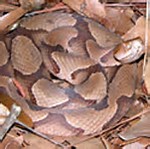
Many in the panhandle use the terms cottonmouth and copperhead interchangeably. They are closely related but this photo of a copperhead shows the lighter coloration and the hour-glass shaped pattern of the blotches along the body.
Photo: UF IFAS Wildlife
BEHAVIOR
- cottonmouths are found throughout the southeast United States but avoid mountainous areas
- they are usually found with 30 feet of a water source, though some have been found as far as 100 feet away
- they prefer slow, quiet, backwater areas over faster flowing waterways
- they are most common in pine flatwoods but can be found in a variety of habitats and do well near humans
- they have been found in brackish water areas but freshwater is usually nearby
- they are becoming more common on barrier islands, and in some cases in high numbers, but do need sources of freshwater; they cannot extract from seawater
- cottonmouths hunt primarily at night; though daylight hunting happens
- on cool mornings they may climb lower branches of trees to bask; usually close to water
- they will remain still in one location for long periods of time waiting for prey to come within range; but they are known to stalk prey as well
- when prey are found they will strike using their hollow fangs to inject a hemotoxin; this venom is known to contain components that cause death, by attacking the muscle and circulatory system, and digestive enzymes to begin the process before swallowing
- in the cooler parts of their range cottonmouths will hibernate; but tend to be active year round in FL
PREY
- cottonmouths are carnivorous and opportunistic; prey include fish, small mammals, reptiles and birds; they will feed on smaller cottonmouths
- they are known to scavenge and are attracted to the smell of dead fish
- they hunt primarily at night but are known to during daylight hours as well
- they hunt fish and CAN bite underwater – despite the legend that they cannot
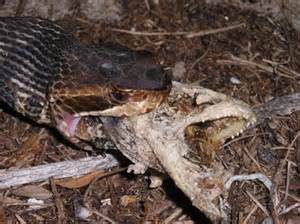
Cottonmouth’s are known to feed on a variety of prey including carrion.
Photo: University of Florida
PREDATORS
- primary predator include alligators, kingsnakes, and larger cottonmouths
- secondary predators include large mammals, birds, hawks, and owls
- cottonmouths tend to “freeze” when they first detect a predator – no movement at all
- if the predator gets too close they will vibrate their tail in leaf litter to alert the intruder and may gape their mouth showing the white inside of their “cottonmouth”; they may also flatten their bodies to appear bigger and release a musk as a warning
- they prefer to flee than bite but they will strike if they have nowhere to flee
REPRODUCTION
- mating occurs in spring and sometimes fall; in Florida they may mate year round
- males sense pheromones from females to know when it is time and, like other vipers, males may fight for the right to mate
- females can store sperm for long periods of time and typically breed every other year
- females give live birth in late summer to early fall; they sometimes congregate to give birth
- the average number of offspring/litter is 7-12 but can be as high as 22
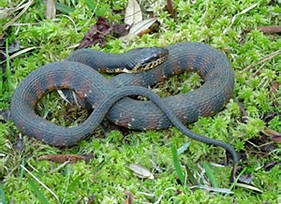
Is this a cottonmouth?
No, it is not…
Can you tell why?
Photo: University of Florida
DEALING WITH ENCOUNTERS
KEEPING THEM AT A DISTANCE
- when hiking in cottonmouth territory it is recommended to wear high boots and look down while walking; if you need to look ahead we recommend you stop walking – look ahead – and then put your eyes back to the ground while walking
- stay on trails; snakes do not like short grass; avoid walking in tall grass where they may be hiding
- to keep cottonmouths away from your home – reduce food sources, freshwater sources, and shelter areas
- cottonmouths like fish ponds and are often found in the filter system; they may be attracted to swimming pools
- cottonmouths also eat rodents; bird feeders, sacks of corn, wood and brush pikes can attract cottonmouth prey, and thus cottonmouths
- if you must have brush piles and bird feeders place them away areas where people frequent – away from front and back doors, sidewalks, etc.
- many properties have natural ponds and swimming pools; if encounters are a problem consider placing some small mesh fencing to keep them from reaching the source may be helpful; this fencing should be buried 2-6″ below the surface and the wooden stakes should be on your side of the fence – snakes can climb the rough wood stakes; if you cannot continue the fencing across your entire property – make a 90° turn AWAY from your property to encourage them to return from where they came
IF I ENCOUNTER ONE
- despite stories, cottonmouths do not chase people; most will sit very still hoping you do not see them; I have personally accidentally placed my foot within inches of a cottonmouths with no reaction from the snakes; their first reaction is to “freeze”
- if they feel you are getting too close they often will begin to vibrate their tail very fast; this means they are getting nervous and are warning you to stay clear; many times they are in leaf litter when they do this and you can hear them – DO NOT APPROACH ANY CLOSER; the probability of a strike is still low, but has increased
- another warning behavior is mouth gaping and showing of white mouth- “cottonmouth”; though strike probability is still low, studies show that gaping cottonmouths tend to strike more often than tail vibrating ones – DO NOT APPROACH; move back and allow the snake to pass

The dark phase of the cottonmouth. This is an older individual.
Photo: UF IFAS
BUT WHAT IF I ALLOW IT TO PASS AND IT IS HEADING FURTHER ON TO MY PROPERTY?
- great news right?
- statistics show that about 95% of people bitten by snakes are trying to catch it or kill it – so trying to remove it yourself significantly increases your chance of getting bit
- many have had success with sweeping non-venomous snakes into a trash can with a broom and releasing somewhere… But these are non-venomous snakes, we recommend professionals for venomous snake removal
- you may have no other optional than to kill the snake; if this is the case be careful… Again, many are bitten trying to kill snakes; also know that snakes are known to strike after they are a dead
WHAT IF I AM BITTEN?
- first know that death from cottonmouths is very rare; annually in the U.S. about 7,000 – 8,000 people are bitten by venomous snakes (about 1 in 40,000 people) and about 5-6 die (about 1 in 50 million)
- also know that many times vipers give what is called a “dry bite” – no venom injected; but you do not know this so treat as if venom was injected; MANY WHO DIE FROM VENOMOUS SNAKE BITES DID NOT SEEK MEDICAL ATTENTION
- first rule is DO NOT GET BIT TWICE; after being bit many people will then try to kill the snake and are bitten again; many feel that they need the snake at the hospital for identification – they do not
- second rule is to remain calm; easier said than done, but an elevated heart rate will move the toxin within the blood faster
- with toxic viper bites there will be pain and swelling; remove watches, jewelry, or any tight fitting clothing from bite area
- you do not need to add ice or heat
- we do not recommend tourniquets, lancing the bite and sucking out venom; many times the venom has spread from the bite area and health officials have found that many times there are more problems with the “first aid” than with the bite itself
- try not to move the limb where bite occurred- easier said than done; if you can elevate your heart above the bite this is good
- do not drink alcohol; you may think you need a drink right now but you do not; alcohol or caffeine can accelerate heart and spread venom faster
- call 911 and alert the closest hospital that you have a snake bite victim coming in; answer any questions they may have to the best of your ability
- again, do your best to relax and get to a hospital; fatalities are rare due to the excellent medical care in this country
All of this said, there is a lot of concern surrounding cottonmouths in Florida. As we expand our neighborhoods into more of their habitat, we will encounter more of them. In some cases, the location for their resources may be our neighborhoods. We will need to learn how to identify them and understand their behavior to avoid negative encounters. The statistics show that they are not as big a threat as they are perceived to be, but folks are still concerned for their family and pets – and understandably so. Hopefully information in this fact sheet will be of help to you.
REFERENCES
Ashton, R.E., P.S. Ashton. 1981. Handbook of Reptiles and Amphibians of Florida; Part I Snakes. Windward Publishing. Miami FL. pp. 175.
Gibbons, W., M. Dorcas. 2005. Snakes of the Southeast. University of Georgia Press. Athens, GA. Pp. 253.
Gibbons, W. 2017. Snakes of the Eastern U.S. University of Georgia. Athens GA. pp. 416.
http://www.bioone.org/doi/abs/10.2994/1808-9798(2008)3%5B175:TEOICS%5D2.0.CO%3B2
http://www.bioone.org/doi/abs/10.1643/CH-04-243R1?journalCode=cope
https://academic.oup.com/bioscience/article/58/10/947/245888/Pitviper-Scavenging-at-the-Intertidal-Zone-An
http://escholarship.org/uc/item/9j69w675
http://ufdc.ufl.edu/files/UFE0046057/00001/WIXSON_J.pdf
http://www.herpconbio.org/Volume_10/Issue_2/Hanson_McElroy_2015.pdf
http://onlinelibrary.wiley.com/doi/10.1111/j.1365-2699.2008.02075.x/full
http://www.bioone.org/doi/abs/10.1643/0045-8511(2002)002%5B0195:DBOCAP%5D2.0.CO%3B2
https://academic.oup.com/beheco/article/15/2/365/223992/Size-based-variation-in-antipredator-behavior
http://www.jstor.org/stable/3890390?seq=1#page_scan_tab_contents
https://www.floridamuseum.ufl.edu/herpetology/fl-snakes/list/agkistrodon-piscivorus-piscivorus/
http://ufwildlife.ifas.ufl.edu/pdfs/cottonmouth.pdf
Johnson, S.A. Frequently Asked Questions About Venomous Snakes. http://ufwildlife.ifas.ufl.edu/venomous_snake_faqs.shtml.

























